Hexbeam modelling (Part 2)
In Hexbeam Modelling (Part1) we discussed the principles behind building a reliable Hexbeam simulation model. Of course the acid test of a simulation model is whether or not the results it predicts turn out to be true in practice. Between August 2006 and February 2007 I built three Hexbeams - two 4 band designs (20/17/15/10) and one experimental 10m monobander. At that time I didn't have the facilities to measure accurately the forward Gain and F/B of these antennas; but I was able to carry out numerous impedance measurements using an MFJ259B and a Palstar ZM-30 antenna analyser, and to compare the measurements with EZNEC predictions.
Predicted EZNEC impedances were quite close to measured values, but there was a consistent "frequency offset" which I could not account for; it was equivalent to about 1.3 inches of wire on all bands from 20m thru 10m. At the time I reluctantly accepted this as "one of those things" and simply made a 1.3 inch correction to my EZNEC models.
However, more recent practical work on my Broadband design has highlighted the significant affect that the small connector blocks (used for fixing the wires to the end-spacing cords) can have. The capacity they add at the ends of the wires appreciably changes the tuning of the Driver and Reflector elements - by an amount consistent with the 1.3 inch "EZNEC error". I now include this block in my models and get excellent agreement between predicted and observed tuning.
The following charts compare the measured and predicted Resistance, Reactance and SWR, of a 10m monoband Classic Hexbeam mounted at a height of 10.5ft:
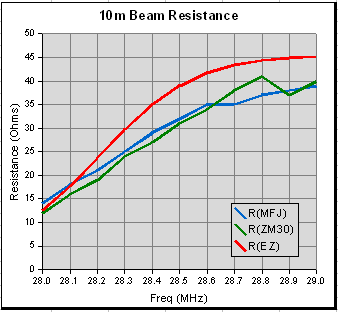
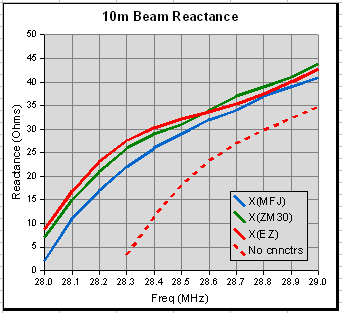
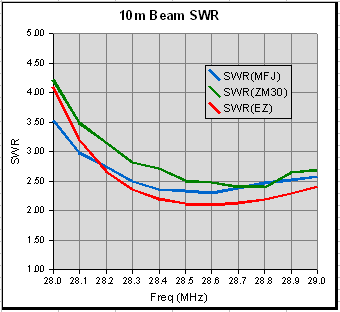
We see that:
- the predicted Resistance is very accurate at the bottom of the band, but is a little high at the top of the band. The "worst case" error is about 17%;
- the predicted Reactance is very accurate; discrepancies are no worse than those between the two antenna analysers!
- for comparison, the Reactance chart also incudes the values predicted if the effect of the connector blocks is not modelled. The result is a very significant frequency error of about 350KHz;
- the predicted SWR is also in good agreement with the antenna analysers, and again the discrepancies are no worse than those between the two instruments.
Recent practical work on the Broadband design provided another opportunity to compared modelled results with the figures measured in practice. You can download the EZNEC model of the 5 band beam which I used, here. Take a look of the impressive accuracy with which EZNEC predicts the F/B and SWR performance of a 5 band Broadband Hexbeam on 20m:
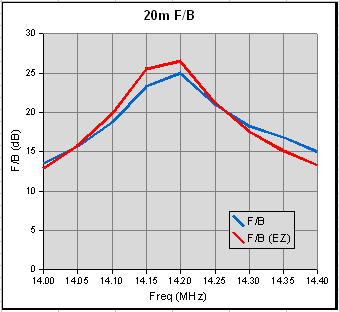
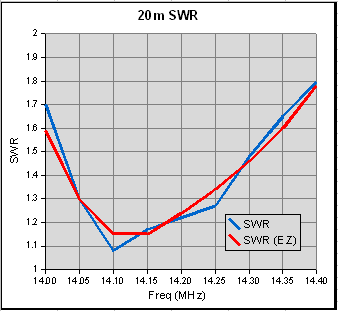
We conclude from these examples that the HexBeam can be simulated in a way that produces useful results.
I have used EZNEC models to predict successfully:
- the effect on beam tuning of varying the height above ground;
- the impact on matching of different interconnections on multiband arrays;
- the shape of the SWR curve as an aid for determining the frequency of best F/B on the Classic design;
- the dimensional changes needed for Beta matching;
- the dimensional changes needed for "unusual" band combinations on multiband arrays;
- perhaps most convincingly, EZNEC modelling confirmed my early ideas about an alternative reflector shape, and led directly to the new Broadband design.
Given the reliability of the simulation work for parameters which I can check-out in practice, I am very confident that other parameters which I cannot check out are also likely to be valid.